We don't know much about Grandma's early life, where she went to school and how she liked to spend her time. We don't even know how she met Grandad, only that they married in 1929 and moved to South Africa to raise a family. What we do know, though, was that she had a cousin named Elsie with whom she corresponded for years and of whom she was very fond.
Until yesterday, my attempts to track down Elsie had been wholly unsuccessful. Without the benefit of a maiden name or married surname, I had been forced to try other approaches: Research the siblings of my ancestors and look among their descendants for girls named Elsie, Ellen or Elizabeth. Assume that Elsie was a Wilson because Grandma's mother was a Wilson and the relationship might not be that of first cousin. Perform a search for marriages of people named Elsie and Ted plus variations on those names. Alas, all my efforts proved fruitless. It was a brick wall in my genealogy quest and yet I felt convinced the solution was very close.
The reason for my confidence was that I knew about Auntie Elsie from my lived experience. As a child, I often heard Grandma say, "I got another letter from Auntie Elsie this week" or "I must write and tell Auntie Elsie about that." Of course, I took no notice. Being young and preoccupied with what I could grasp first-hand, I simply failed to pay attention.
More recently, I tried quizzing my aunt Gillian for anything she could tell me. She remembered that Elsie was married to Ted but had no idea whether there were any children. Her memories are so scant because she only met them once. It was on a family holiday to England, one of the five-yearly trips that happened when her father visited the London office of Hollerith. Gillian recalls that, when they visited Auntie Elsie and Uncle Ted in East Ham, they were building a bomb shelter in the front yard. She also recalls seeing barrage balloons hanging over London and the need to close all the curtains at dusk for the blackout. Coming from a context where life involved carefree expeditions up the mountain to boil potatoes in a billy-can and watching her father learn to sail, she was naturally struck by the strangeness of it all.
Such was the extent of my knowledge about Elsie and Ted. I had reached the point where my notes on the elusive couple languished in a file awaiting inspiration. Then, this past week, Ancestry made an offer I could not refuse. I had a free account, created when they were offering free access to military records a little while ago, and they saw fit to reach out to me , offering a three-month subscription for just one dollar. Unfortunately, Ancestry is hard to use with accessibility software for blind users so I won't be using it long term. However, the effort it took to build a basic family tree was well worth it because I made a startling breakthrough!
My first Ancestry hint led me to a profile for Grandma. This was unexpected because she had been an only child and I hadn't found her included on any other online family trees. Checking the details for her parents and grandparents, I satisfied myself that there was no mistake. Then I set about tracing the relationship between myself and the owner of the tree.
I hadn't been thinking about Elsie and Ted when, suddenly, I found an Elsie Ada Bristow from West Ham. The name caught my attention, as did her birth date of 1907, just two years later than Grandma's. She was married to an Edward Collins, which ticked the box for Uncle Ted. To top it all, the couple lived in East Ham in 1939, the year in which Grandma, my aunt Gillian and my mother had seen them.
What a find this is! The online family tree makes it possible for me to contact the owner and exchange information. She obviously knows more about Grandma's extended family than I do, while I know more about her children and grandchildren. This opens up a whole new line of investigation. Not only do I have a slew of new names, dates and locations to research, but I have DNA results to compare, photos to share and new ancestors to care about. So many possibilities for exploration!
Photo credit: "A man sits on a park bench in London 1940" by Christine

